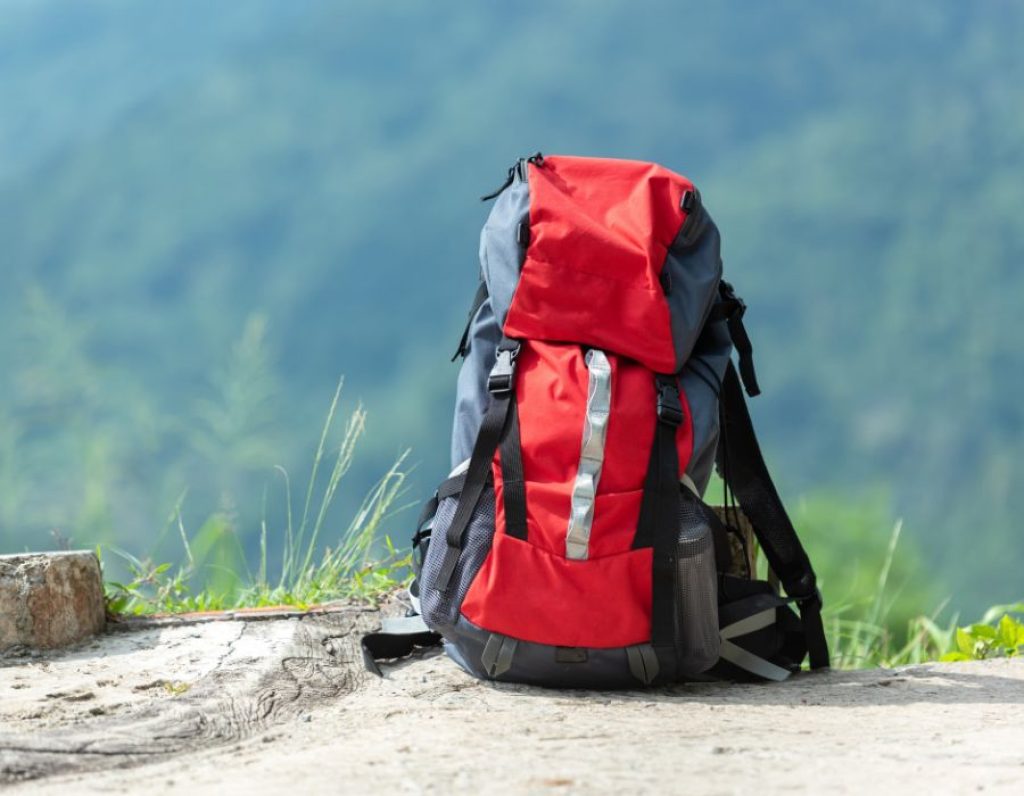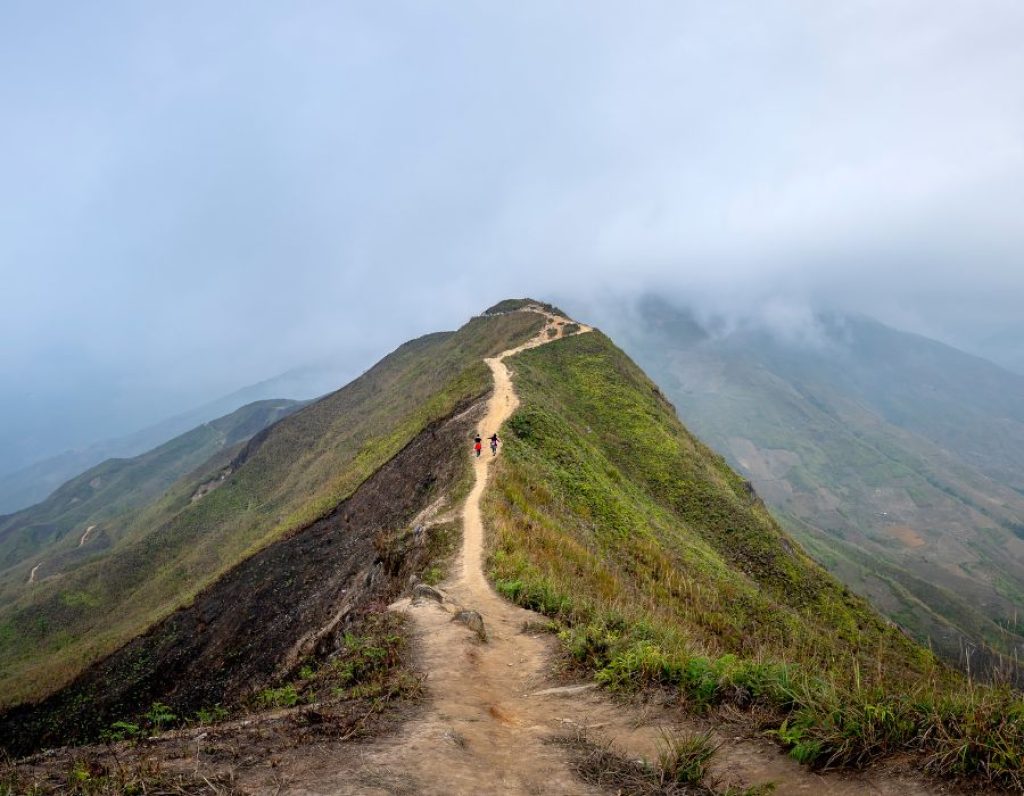
Almost all negative natural phenomena that can be found on Earth are characteristic of mountains. Intense solar radiation can be combined with low temperatures, dry air with excessive waterlogging underfoot, calm within a few minutes can change to hurricane winds, etc. If you add low barometric air pressure and lack of oxygen, the picture becomes complete. Such difficult climatic conditions have a negative impact on well-being, weaken physical strength, and greatly full attention.
It is necessary to prepare for a mountain crossing carefully. Carefully inspect your shoes, wash your feet, carefully straighten your socks or foot wraps so as not to rub your feet, and lighten your load to the limit, taking with you only the essentials. When placing a load behind your back, you need to put something soft between the load and your back and wrap the thin straps of the backpack. To do this, you can use grass or moss tied into a soft mat.
In the mountains, technique is especially important, both the technique of movement itself and the technique in the sense of equipment. Bad crampons will let you down at the most inopportune moment; a rotten, frayed rope instead of insurance can cause an accident. While moving, you need to monitor the rhythm of your breathing, breathe calmly, inhale deeply only through your nose and exhale completely.
When going uphill, you should not talk and under no circumstances should you smoke. If the normal breathing rhythm is disrupted, make short stops for 3-5 minutes. You should walk at an even pace, bending slightly and without straining. On the ascents, move your body slightly forward and place your leg on the entire foot without jerking. When descending, lean your body back and place your foot on the heel to avoid slipping and falling.
Slopes

When moving along gentle slopes, you must ascend and descend mountains in a straight line. If the slope is covered with bushes, try to get around them or move through clearings. What you need here are simple, durable shoes with grooved soles and clothing that covers all parts of the body. On grassy slopes, there are often gullies, holes, tree trunks, and stones that are invisible due to tall grass, so you need to look at your feet and take your time carefully.
Low grass, when wet, becomes very slippery, so when moving along wooded and grassy slopes, for self-insurance, you must have an alpenstock or a strong stick. If you fall, you must immediately take all measures to arrest yourself. To do this, you should turn around to face the slope and start braking with an ice axe, alpenstock or anything else in your hands.
When moving up a grassy slope, your leg should be relaxed forward, bending forward more the heavier the load and steeper the slope. When the ascent is straight, your feet should be placed at an angle to each other, spreading your toes in a herringbone pattern.
Steep Slopes
As the steepness of the slope increases, the step becomes shorter. The leg is placed on the entire foot. In this case, the feet should be placed in a “ladder” or “herringbone” pattern. Along steep, long grassy slopes, you should walk in zigzags. The width of the step should be commensurate with the steepness of the slope. The steeper the climb, the smaller the step. On the descent, the step increases slightly. When changing direction, always start with the leg that is higher up the slope, which will avoid crossing your legs and resulting in loss of balance. When climbing steep slopes, bring your knees together after each step to give your muscles a rest.

If the slope is covered with sparse scree or stones, try not to push the screen down. On steep rocky slopes, you need to step carefully so as not to push stones down. On steep slopes, it is recommended to use a stick. To make it easier to climb steep, slippery, clayey or icy slopes, steps should be cut at a distance of approximately 50 cm from one another. In soft ground or snow, steps can be knocked out with shoes.
When descending, bend your knees and walk straight down. If you feel like you’re going too fast, sit down and press your heels into the ground. Try not to step on loose stones or scree. When lifting, check any support before placing your foot on it. Avoid stepping on rocks or logs that could move under your feet.
On steep slopes, you need to wrap your feet with rope or wire or make a special device to prevent your shoes from slipping. It is recommended to loosen the belt slightly and unbutton the collar. You can jump down only onto loose soil and only if there are no unexpected dips below. Spread your feet shoulder-width apart, land on your heels and slide down. If, as you increase your speed, you feel like you are losing control of the descent, jump again. But it is much safer to descend with a rope.
Scree Slopes
Slopes with a small screen – move obliquely or serpentine. You need to move along slopes with a small screen obliquely or serpentine, choosing medium-sized stones for the setting. The simplest technique is to descend along a continuous small screen, along which you can “slide”, sliding along with the stones, but if larger stones and rock fragments begin to move, you must quickly move to the side.

Medium screen. Avoid sudden movements, and walk carefully without causing rockfalls. The ice axe is useless because… the support on it is unreliable, and you can accidentally push over a lying stone. The large screen is usually very fragile, especially after rain or snow. Before you step on another piece of debris, you need to make sure that it is stable. When moving along a large screen, before stepping on another piece of debris, you need to make sure that it is stable. It is safer to step on the end of the stone closer to the slope.
When overcoming unstable rocks, screes, or narrow passages over a cliff, place your feet depending on the support points and do not lift your leg until the other leg is firmly placed forward.
Rocky Slopes
Before you begin to pass through an area with complex rocky terrain, you must take all precautions, outline an approximate route of movement, and mark the most difficult areas, rockfall sites and places to bypass them.
When climbing, it is better to see what you can grab onto, but it is still safer to go around the obstacle than to overcome it. Map out your route from the very bottom; do not press your body against the rock; place your feet straight and look up. Don’t overexert yourself.
Moving across the plain, we use only one point of support. We stand on one leg, move the other, and our hands are free. Movement on rocks requires “three steps of support.” This means you need to move so that in more or less difficult areas while moving one limb, the other three do not come off the support.
On light rocks, the hands usually only maintain balance and actively work only where there is no comfortable and reliable support for the legs. The torso should be kept as vertical as possible, and the arms and legs should be spread at least shoulder width apart.
You should rest on the ledges with the inner welts of your boots. Never cross your legs. When using the grip, do not press against the rocks. This will provide better conditions for footwork. You need to move smoothly, without jerking – this makes it easier to maintain balance and save strength.
To move, you need to alternately use stops and spacers, preferring the latter: with spacers, there is less risk of failure and stress on the fingers. In difficult areas, but convenient for moving with a spreader, you need to move straight up. If you need to move to the side, you need to do this in easier areas. In the absence or insufficiency of reliable supports on a rocky area, it is necessary to make full use of friction (on slabs and scallops) and wedging force (in corners and crevices).

To get out of the aperture, press your back against one wall and your feet against the other, then begin to rise slowly. When moving along rock-slab slopes, you need to be especially careful in areas where the slabs have a large angle of inclination and poor connection with each other. In poor weather conditions, such areas are practically impassable.
The easiest to navigate along rocky slopes are ribs, buttresses, and couloirs, but they are more dangerous due to possible rockfalls. Descending along particularly steep and long couloirs should be avoided. It is prohibited to descend during or after snowfall and rain because, in these areas, the likelihood of a breakdown increases, and it is very difficult to stop sliding down.
Descending from a rocky slope is sometimes much more difficult than climbing because the slope is not completely visible. As a result, additional difficulties arise in organizing its passage. It is safer to make smooth movements, staying closer to the rock.
You should go down the steep slope, facing the rock. On less steep slopes with larger ledges, walk sideways, using your palm for support if necessary. When going down gentle slopes, you can walk as usual, leaning your body back slightly and carrying the load in front of you (if possible).
When descending, it is safer to make smooth movements, staying closer to the rock. If, in extreme conditions, you need to climb a rocky cliff at all costs on wet and moss-covered rocks, then it is better to do this not in boots but in socks because socks provide better traction on slippery rock surfaces than shoes.
Snowy Slopes

- It is better to go early in the morning.
- When the snow is still fastened by night frost, a strong crust.
- On slopes with loose snow, walk carefully because of the high probability of avalanches.
- climb a steep slope facing it, knocking out the steps with the toe of your boots.
- It is better to climb snowy slopes early in the morning. The snow and crust will be frozen, and this will save you from the need to trample down the steps and save a lot of effort.
- It is safer to climb a steep, snowy slope head-on. You need to walk on hard crust with crampons and mandatory insurance.
You should not sharply kick into the snow – it is better to compact the footprint in it with two or three pressures. When moving on a fragile crust, you should not try to stay on its surface. It’s better to break through the crust and trample down the step. You should walk on slopes with loose snow carefully because There is a high probability of an avalanche here.
When driving on snow, self-belay with an alpenstock is observed. The ascent along steep sections is organized in three steps. He sticks an alpenstock in front of himself and, holding it with his hands, drives first one leg into the snow, then the other, the alpenstock is moved higher, and the movement is repeated in the same sequence.
On gentle slopes, they descend facing the valley and press their heels into the snow as firmly as possible. The alpenstock is held at the ready. On gentle slopes, free of rocks and cracks, you can go down with a sliding step reminiscent of ice skating, using an ice axe for protection.
Snow and Glaciers

Unless you have a good ice axe, spiked shoes and the skills to use them, try to avoid glaciers. Climb steep slopes in a zigzag pattern, breaking through steps. To maintain balance, place the ice axe or pole slightly to the side. On sloping slopes, drive your heels into the packed snow and use a pole. When descending steep slopes, move backwards, leaning on a pole stuck in the snow. If you slip, it will act as a brake and help keep you in place. But under no circumstances use this method if there is a threat of an avalanche.
If one of the group members falls into a crack, then he should be raised to the surface with all precautions taken: squeezing the chest with a rope can lead to suffocation. Lower the rope with a loop that will take the entire load when the person inserts their foot into the loop. If the fallen person has lost consciousness, then the joint efforts of three people with safety equipment will be required to raise him. It is necessary to act as quickly as possible: the temperature in the cracks is very low, and the victim will quickly freeze.








